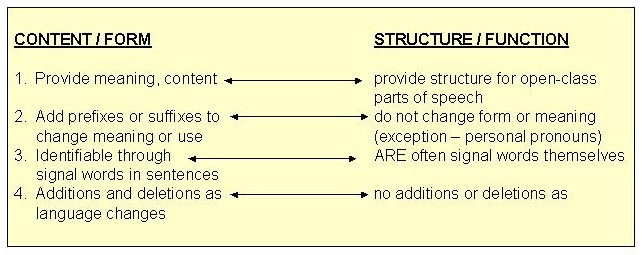PARTS OF SPEECH
Different schools of grammar present different classifications for the parts of speech.
Traditional grammarians, for example, base designations on a word's meaning or signification.
|
Example: |
A noun is a word that names a person, place, thing, or idea. |
Structural grammarians see parts of speech as often identifiable through their position in sentences.
|
Example: |
Her _________ was on the table. (noun) |
Using valuable ideas from both groups, we may divide parts of speech into two major groups:
|
2 Classes: |
||
|
1) content words (open class) |
||
|
2) function words (closed class) |
||
Content words are words that have meaning. They are words we would look up in a dictionary, such as "lamp," "computer," "drove." New content words are constantly added to the English language; old content words constantly leave the language as they become obsolete. Therefore, we refer to content words as an "open" class.
Nouns, verbs, adjectives, and adverbs are content parts of speech.
Function words are words that exist to explain or create grammatical or structural relationships into which the content words may fit. Words like "of," "the," "to," they have little meaning on their own. They are much fewer in number and generally do not change as English adds and omits content words. Therefore, we refer to function words as a "closed" class.
Pronouns, prepositions, conjunctions, determiners, qualifiers/intensifiers, and interrogatives are some function parts of speech.
Note the differences between content and function parts of speech:

Generally, we can use one or more of five signals to help us determine a word's part of speech designation:
|
1. function words (the, what, and) |
|
|
2. inflectional morphemes (-s, -ed) |
|
|
3. derivational morphemes |
|
|
4. word order in sentence patterns |
|
|
5. stress patterns (subJECT/SUBject, INsert/inSERT, IMprint/imPRINT) |